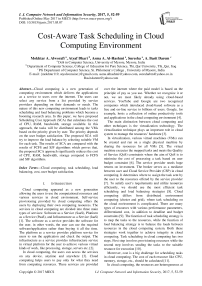Cost-Aware Task Scheduling in Cloud Computing Environment
Автор: Mokhtar A. Alworafi, Atyaf Dhari, Asma A. Al-Hashmi, Suresha, A. Basit Darem
Журнал: International Journal of Computer Network and Information Security(IJCNIS) @ijcnis
Статья в выпуске: 5 vol.9, 2017 года.
Бесплатный доступ
Cloud computing is a new generation of computing environment which delivers the applications as a service to users over the internet. The users can select any service from a list provided by service providers depending on their demands or needs. The nature of this new computing environment leads to tasks scheduling and load balancing problems which become a booming research area. In this paper, we have proposed Scheduling Cost Approach (SCA) that calculates the cost of CPU, RAM, bandwidth, storage available. In this approach, the tasks will be distributed among the VMs based on the priority given by user. The priority depends on the user budget satisfaction. The proposed SCA will try to improve the load balance by selecting suitable VM for each task. The results of SCA are compared with the results of FCFS and SJF algorithms which proves that, the proposed SCA approach significantly reduces the cost of CPU, RAM, bandwidth, storage compared to FCFS and SJF algorithms.
Cloud computing, task scheduling, load balancing, cost, user budget satisfaction
Короткий адрес: https://sciup.org/15011851
IDR: 15011851
Текст научной статьи Cost-Aware Task Scheduling in Cloud Computing Environment
Published Online May 2017 in MECS
Cloud computing appeared as a new generation allowing the users to use the computational resources and various services in cloud environment. Self-service provisioning provided by cloud computing offers the users by deploying their own computing resources. The services in cloud computing are divided into three main types of services: Software as a Service (SaaS), Platform as a Service (PaaS), and Infrastructure as a Service (IaaS) [1]. The software as a service provides the software for the user, in other words, the user can use the required software/application rather than buying it all the time. The platform as a service provides platform service for users to run the application and check the output. The infrastructure as a service provides infrastructure service in virtual platform for the user to achieve various virtual kinds of work, like processing, storage, servers etc. [2].
In cloud computing, the users can access the services on any device, anytime and anywhere [3]. Cloud computing helps users to pay only for what they need from computing resources. These services are provided over the internet where the paid model is based on the principle of pay as you use. Whether we recognize it or not, we are most likely already using cloud-based services. YouTube and Google are two recognized companies which introduced cloud-based software as a free and on-line service to billions of users. Google, for example, hosts a collection of online productivity tools and applications in the cloud computing environment [4].
The main distinction between cloud computing and other techniques is the virtualization technology. The virtualization technique plays an important role in cloud system to manage the resources’ hardware [3].
In virtualization, various virtual machines (VMs) can be created and run on a single physical machine by sharing the resources for all VMs [5]. The virtual machine executes the mapped tasks and meets the Quality of Service (QoS) constraints where the aim of QoS is to minimize the cost of processing a task based on user budget constraint [6]. The service provider needs huge returns on investment. The broker serves as a mediator between user and Cloud Service Provider (CSP) in cloud computing. It determines where to assign the task sent by the user to the resources offered by the service provider [7]. To satisfy user’s requirements and utilize resources efficiently, we should use the most efficient task scheduling and load balancing strategies [8]. Cloud computing differs from distributed environment computing (cluster and grid), where task scheduling on the cloud environment is complicated. There are many types of resources with various performance parameters, differentiated cost, in addition to deadline and budget constraints [9]. The function of task scheduling strategy is to map the tasks to the resources, while the function of load balancing strategy is to balance the loads between resources in the cloud computing system. Both these strategies work together to achieve integrity in cloud computing. Task scheduling in cloud computing has two steps. First step involves provisioning resources while the second step involves sending the tasks to the suitable resource for execution [10].
Moreover, cost is a big challenge for scheduling tasks in cloud computing. The cost of each resource like CPU, memory, storage, etc., should be calculated [11].
In cloud computing, the resources are heterogeneous at different data centers. So, classical scheduling algorithms such as FCFS, shortest job first and priority etc., are not recommendable. Some effective scheduling techniques are required which can optimize and enhance the overall performance of scheduling algorithm. The scheduling algorithm should provide user satisfaction at the end [7].
The main contribution of this paper is to examine how to reduce the cost of task execution time, memory, bandwidth, and storage based on task priority while processing tasks in several virtual machines by ensuring estimated finishing time to be as less as possible.
This paper is divided into the following sections. The related work is presented in section two. Section three presents the proposed approach. In section four, the result of experiments is illustrated. Evaluation performance is shown in section five. Finally, the conclusion is provided in section six.
-
II. Related Work
Nowadays, there are plenty of scheduling algorithms, each one had its own constraints that used to efficiently schedule the task on the resources. For example, Selvarani and Sadhasivam [12] concentrated on scheduling groups of tasks in cloud computing when resources have different cost and computation performance. The scheduling method employed an enhanced scheduling algorithm based on the cost for an effective mapping of tasks to the resources in order to enhance the ratio of computation and communication.
In addition, Ruben et al. [13] tackled this problem by proposing a set of heuristics to cost-effectively schedule deadline-constrained computational applications on both private infrastructure and public cloud providers. The heuristics took into consideration the transfer and computational cost of each data in addition to data transfer times
Gaurav Raj and Sonika Setia [14]. proposed an efficient communication scheme between broker and VMs for assigning the task. The optimum time and cost could be obtained by utilizing Broker Virtual Machine Communication Framework (BVCF). Scheduling over virtual machine and tasks and Retransmission of those tasks was the major point of the proposed work. The execution of tasks was analyzed over Round Robin and FCFS scheduling policies.
In addition, Yogita and Mansi [15] depended on task scheduling policy for making efficient sending of tasks to available resources in cloud computing system. Their objective was to add cost based task scheduling, which benefits the user and dynamically optimized policy of resource allocation that is beneficial to the service provider. In addition, it enhanced communication, computation ratio, and utilization of resources available based on combining the user tasks before resource allocation.
Sheeja and Jayalekshmi [16] proposed an algorithm to balance the load in VMs efficiently by distributing the tasks between the VMs based on the foraging behavior of honey bees. If there were more than one under-loaded virtual machines, the most cost-efficient one was selected using Pareto dominance strategy. The result of this algorithm seemed efficient when evaluated with existing algorithms and it also decreased the cost of using virtual machine instances. While at the same year, Gang Zhao [17] proposed PSO modification algorithm to solve the scheduling of tasks problem in cloud computing. They quantified the cost of resource usage by a cost-aware fitness function, along with the fitness service for time cost, with the objective of decreasing both the time of the process and the resource utilization. Therefore they could reach a global optimal solution. The simulated cloud computing environment showed the effectiveness of their proposed algorithm.
In 2015, there were an enhancement as at [11] Nidhi Bansala et al. proposed QoS-driven scheduling to compute the cost of the task, then evaluated it with conventional task scheduling algorithm in cloud computing system. The results of QoS algorithm achieved good performance using the cost parameter.
Another recent novel algorithm in 2015, Verma and Kaushal [18] proposed Bi-Criteria of Priority according to Particle Swarm Optimization (BPSO) policy to schedule workflow tasks. The comparison and simulation were done with state-of-art algorithm. The result of the simulation proved that the extended BPSO algorithm has reduced the implementation cost of schedule as compared to the state-of-art algorithm based on the same deadline and budget constraints taking into account the exiting load of the resources. Furthermore in 2016, Moïse and Chou [19] solved cost optimization problem for scheduling DAGs on an infrastructure as a service cloud computing. They proposed optimal and heuristic scheduling policies and compared across a variety of DAGs using the price model from EC2.
The results of cost-aware heuristic algorithm when compared to other cost-oblivious DAG schedules that aim to reduce makespan or resource utilization, showed that it minimized cost by 20–50 % and achieved a cost within x1.16 of the optimal one.
-
III. Propsed approach
Cloud computing environment consists of many heterogeneous resources called data centers, which include a number of hosts (servers) that have several characteristics, where each host has a number of VMs with various configurations (CPU, memory, bandwidth and storage). The requests will be sent to resources from the user by the service provider. The service provider serves these requests with efficient algorithms. The service provider executes tasks in virtual machines using scheduling algorithms that are available on resources. In this proposed approach, we used two clusters with different configuration based on speed: fast speed cluster and slow speed cluster. The clusters have several VMs with different costs. These VMs are independent and parallel processing. The user requests are represented by a group of independent tasks T=T1, T2, T3,…..Tn.
In this paper, we used many abbreviations. Table 1
shows all the abbreviations used in our proposed approach.
Table1. Abbreviations used in the Proposed Approach.
|
Symbol |
Explanation |
|
VM |
Virtual machine |
|
VM L |
Virtual machine load |
|
DC |
Data center |
|
TL |
Total Length task |
|
Pe e num |
Process element number |
|
Pe • e mips |
Process element million instructions per second |
|
EFT |
Estimated finishing time |
|
Cost C |
Total cost of CPU consumption |
|
Cost R |
Total cost of RAM consumption |
|
Cost B |
Total cost of bandwidth consumption |
|
Cost S |
Total cost of storage consumption |
|
Fit |
File input task |
|
Fot |
File output task |
|
Cost CPU |
Cost of the CPU resource |
|
Cost RAM |
Cost of the RAM resource |
|
Cost Bw |
Cost of the bandwidth resource |
|
Cost Storage |
Cost of the storage resource |
|
C (VM) |
Capacity of VM |
The main idea in our approach is as illustrated in Fig. 1. The tasks are checked based on the priority where the users submit tasks to the resources of CSP that should be implemented based on user budget (task priority). The CSPs have several heterogeneous resources, whereas each resource has its cost and configuration. The SCA determines which virtual machine will consume less estimate finish time and cost for the execution of the tasks by checking task priority, so as to achieve load balancing between VMs clusters. The tasks will be distributed among the suitable virtual machines in clusters according to the following steps. Initially, the load is calculated in VMs based on Equation (1). Tasks priority are checked and the tasks with low priority will be sent to slow speed cluster, while the tasks with high priority will be sent to fast speed cluster. Then, the tasks are mapped to the VM that has less estimation finish time based on Equation (2). This step will obtain balancing between VMs being loaded into a cluster. VMs’ load is updated. Finally, the total cost of all resources is calculated using Equations (3), (4), (5), (6) and (7).
Calculate the load on VM [20] based on Equation (1).
n TL
VM Load (VM,) = ^=1—-
_ L C ( VM )
Where: C (VM) = is the Capacity of VM, it refers to Pe num *Pe mips . Pe num is defined as number of process elements allocated, while Pe mips is the amount of million instructions per second, TL is total task length.
Then, we calculate the estimated finishing time of the present task [21] on VMs cluster based on Equation (2).
Estimated Finishing Time (EFT) = VML + TLr (2)
Where: VML is VM load, TL total length of present task.
Calculate the total cost of processing (CPU) [22] for mapped tasks in each cluster resource (Slow, Fast) by using Equation (3).
n cost = ( *Cost )
C i"1=1 C(VM)
Then we calculate the total cost of RAM, bandwidth and storage of VM based on Equations (4), (5) and (6).
CostR = 2 n = 1((fit, + M ) * cosIram, )
CostB = 2 n = 1 ((fit, + fot,) * CostBw,)
Costs = 2 n = 1(( fit, + fot, )* Coststoragej)(6)
The total cost of all resources can be obtained by Equation (7).
Total cost= (Costc + CostB + CostR + Costs )
The algorithm of the proposed approach is:
Algorithm: Scheduling Cost Approach based on Cost
Priority (SCA)
Input: Set the available resources and unmapped tasks
Output: Show the consuming cost of all resources
Classify the resources into two clusters based on Capacity (speed) as follows:
For i =1 To m number of resources
If Capacity of VM i = low (low = 2000 C(VM)) Classify VM i as slow speed
If Capacity of VM i = high (high =2500 C(VM)) Classify VM i as fast speed
End for
For each task cost priority list
-
- if cost priority is low
-
- Send task to slow speed cluster
-
- if cost priority is high
-
- Send task to fast speed cluster
Each cluster receives task:
-
2 Calculate the load of VMs based on Equation (1). Calculate estimation finish time of task in each VMs cluster based on Equation (2).
Assign task to VM j with less estimation finish time End for
-
3 Calculate the cost of processing task based on Equations (3), (4), (5) and (6).
-
4 Calculate the total cost based on Equation (7).
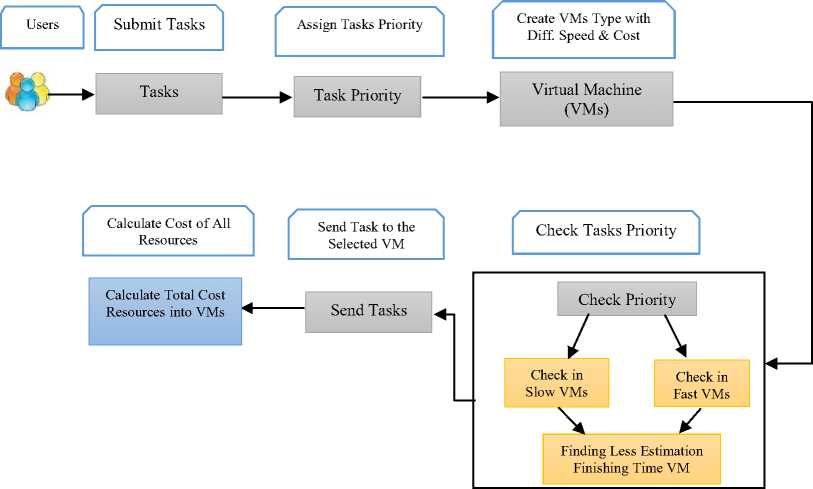
Fig.1. Proposed Approach of SCA
The main idea of SCA is to minimize the cost of resources that execute task by grouping the tasks into various categories based on user budget satisfaction (user cost priority) and then sending each group to different clusters. To achieve load balancing, we calculate the estimation finish time of the task in each VMs in a cluster and sending the task to VM that has less finish time.
-
IV. Experimental Results
For modelling and evaluating algorithms, the researchers are using CloudSim [23]. CloudSim is a simulation toolkit that supports modeling and simulation of virtualized cloud-based data center environments. [24].
The users submitted the tasks in CloudSim and categorized it into various tasks. The tasks are sent for scheduling through scheduling algorithm. Next, the user tasks with corresponding virtual machine are bound through the Data center Broker. The tasks are then run on the virtual machines [25]. In this work, experiments are operated in a simulation framework. Tasks are grouped into the VMs cluster in SCA manner. Each task will be assigned to the cluster type based on the cost priority (high, low).
The virtual machines are grouped into two clusters, one group as a slow cluster, while the other group as a fast cluster. We conducted six experiments for each algorithm. We implemented 75, 150 and 225 tasks on 4 VMs and 450, 525 and 600 tasks on 8 VMs.
Table 2 summarizes the distributed tasks on clusters in each experiment.
Table 2. Number of tasks executed in each cluster
|
Experiments |
No. of Tasks |
Slow speed cluster |
Fast speed cluster |
|
1 |
75 |
46 |
29 |
|
2 |
150 |
63 |
38 |
|
3 |
225 |
140 |
85 |
|
4 |
450 |
280 |
170 |
|
5 |
525 |
328 |
197 |
|
6 |
600 |
375 |
225 |
Fig. 2 shows the number of tasks loaded into virtual machines in clusters.
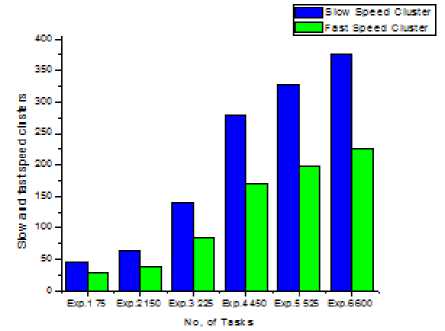
Fig.2. Number of tasks into VMs Clusters
-
V. Performance Evaluation
Performance evaluation of our approach was conducted using six experiments with the same tasks in the same VMs. We evaluated and compared our proposed SCA with FCFS and SJF algorithms. The summarized result in Table 3, shows that our algorithm has better results by minimizing the total cost of CPU processing for all experiments than the other algorithms.
Table 3. Comparing total cost of CPU
|
Experiments |
No. of Tasks |
Total cost of CPU |
||
|
SCA |
FCFS |
SJF |
||
|
1 |
75 |
11427 |
13725 |
14100 |
|
2 |
150 |
23525 |
27117 |
27462 |
|
3 |
225 |
35440 |
41030 |
40925 |
|
4 |
450 |
69952 |
82184 |
81539 |
|
5 |
525 |
81178 |
95560 |
95425 |
|
6 |
600 |
92595 |
109619 |
108645 |
We can observe from Fig. 3 that the performance of SCA is better in all experiments associated with the total cost of CPU than the other algorithms.
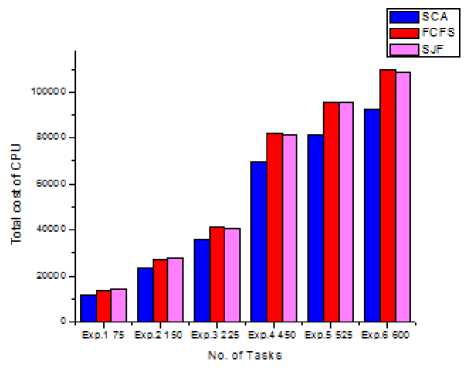
Fig.3. Total cost of CPU
The comparison of total cost of RAM is illustrated in Table 4 and Fig. 4. In all experiments, the performance of SCA is better than other algorithms.
Table 4. Comparing total cost of RAM
|
Experiments |
No. of Tasks |
Total cost of RAM |
||
|
SCA |
FCFS |
SJF |
||
|
1 |
75 |
1161 |
1242 |
1242 |
|
2 |
150 |
2313 |
2475 |
2475 |
|
3 |
225 |
3465 |
3708 |
3708 |
|
4 |
450 |
6930 |
7425 |
7425 |
|
5 |
525 |
8073 |
8658 |
8658 |
|
6 |
600 |
9225 |
9900 |
9900 |
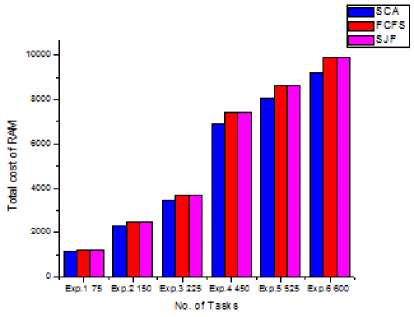
Fig.4. Total cost of RAM
Table 5 summarizes the results of all the implemented experiments and shows that SCA minimizes the total cost of bandwidth compared to FCFS and SJF.
Table 5. Comparing total cost of bandwidth
|
Experiments |
No. of Tasks |
Total cost of bandwidth |
||
|
SCA |
FCFS |
SJF |
||
|
1 |
75 |
14220 |
15840 |
15840 |
|
2 |
150 |
28260 |
31500 |
31500 |
|
3 |
225 |
42300 |
47160 |
47160 |
|
4 |
450 |
84600 |
94500 |
94500 |
|
5 |
525 |
98460 |
110160 |
110160 |
|
6 |
600 |
112500 |
126000 |
126000 |
From Fig. 5 we observed that the performance of SCA is better in reducing the total cost of bandwidth than the state of the art scheduling algorithms.
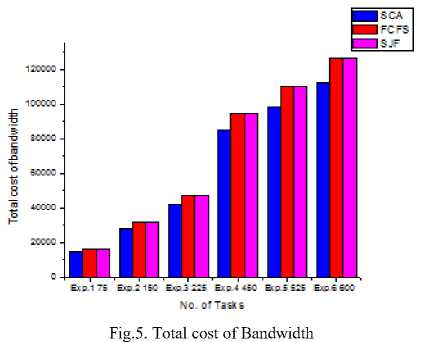
Also in Table 6, the SCA achieves better performance in the total storage costs than the other algorithms, it is also clearly shown in Fig. 6.
Table 6. Comparing Total Cost of Storage
|
Experiments |
No. of Tasks |
Total cost of storage |
||
|
SCA |
FCFS |
SJF |
||
|
1 |
75 |
1074 |
1128 |
1128 |
|
2 |
150 |
2142 |
2250 |
2250 |
|
3 |
225 |
3210 |
3372 |
3372 |
|
4 |
450 |
6420 |
6750 |
6750 |
|
5 |
525 |
7482 |
7872 |
7872 |
|
6 |
600 |
8550 |
9000 |
9000 |
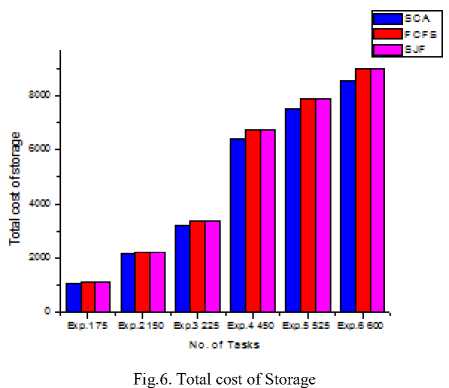
Obviously, the total cost of our SCA approach for a variety of tasks processing efficiently satisfies the user budget satisfaction as summarized in Table 7.
The results in Fig. 7, shows the observed improvement achieved by SCA of the total cost of all resources of VM in all the experiments. The results of our proposed approach are significantly better than the FCFS and SJF.
Table 7. Comparing Total cost of all Resources
|
Experiments |
No. of Tasks |
Total cost of all resources |
||
|
SCA |
FCFS |
SJF |
||
|
1 |
75 |
26808 |
30807 |
31182 |
|
2 |
150 |
54098 |
61092 |
61437 |
|
3 |
225 |
80950 |
91898 |
91457 |
|
4 |
450 |
161482 |
183464 |
184109 |
|
5 |
525 |
187711 |
214243 |
214378 |
|
6 |
600 |
214320 |
244545 |
245519 |
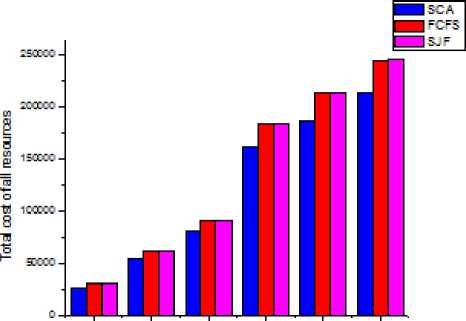
Exo 1 75 Ехо^15О ВП3 25 Ехо* *50 ВО-5 525 ЕХ0.6 6СО
NO OtTSSKS
Fig.7. Total cost of all Resources
Briefly, our proposed approach is efficient and capable of achieving the cost and improving the task scheduling.
-
VI. Conclusion
In this paper, we have presented the cost priority to schedule tasks on cloud resources that meet the user budget satisfaction. The Scheduling Cost Approach (SCA) calculates the cost of all resources. Each task is assigned based on task priority taking into consideration suitable resources for execution and distribution of load balancing between the VMs in clusters. We conducted six experiments to test the performance of our approach. The comparison of SCA was done with FCFS and SJF algorithms under same task priority and resource cost processing. The simulation results show that SCA has outperformed in all cases as compared to FCFS and SJF algorithms in reducing the cost of all resources.
Список литературы Cost-Aware Task Scheduling in Cloud Computing Environment
- Sahal, Radhya, Mohamed H. Khafagy, and Fatma A. Omara, "A Survey on SLA Management for Cloud Computing and Cloud-Hosted Big Data Analytic Applications", International Journal of Database Theory and Application, 9(4), PP: 107-118, (2016).
- Bhandari, Neha A., "Managing Cost and Performing Balancing at Cloud Platform", International Journal of Research in Engineering and Technology, vol. (03), PP: 608-611, April (2014).
- Soni, Ashish, GaganVishwakarma, and Yogendra Kumar Jain, "A Bee Colony based Multi-Objective Load Balancing Technique for Cloud Computing Environment", International Journal of Computer Applications, 114(4), PP: 19-25, (2015).
- Chen, X. J., "Virtual machine resource allocation algorithm in cloud environment", Application Research of Computers, 9, PP: 2584-2587, (2014).
- Kruekaew, B., and W. Kimpan, "Virtual machine scheduling management on cloud computing using artificial bee colony", Proceedings of the International MultiConference of Engineers and Computer Scientists, Vol. 1, PP: 1-5, (2014).
- Baxodirjonovich, KamolovNizomiddin, and Tae-Young Choe, "Dynamic Task Scheduling Algorithm based on Ant Colony Scheme", International Journal of Engineering and Technology (IJET), PP: 1163-1172, (2015).
- Saxena, Deepika, R. K. Chauhan, and Ramesh Kait, "Dynamic Fair Priority Optimization Task Scheduling Algorithm in Cloud Computing: Concepts and Implementations", International Journal of Computer Network and Information Security, 8(2), PP: 41-48, (2016).
- Wang, Tingting, et al., "Load balancing task scheduling based on genetic algorithm in cloud computing", Dependable, Autonomic and Secure Computing (DASC), 2014 IEEE 12th International Conference on, IEEE, PP: 146-152, (2014).
- Thai, Long, Blesson Varghese, and Adam Barker, "Task scheduling on the cloud with hard constraints", 2015 IEEE World Congress on Services. IEEE, PP: 95-102, (2015).
- Rodriguez, Maria Alejandra, and Rajkumar Buyya, "Deadline based resource provisioningand scheduling algorithm for scientific workflows on clouds", IEEE Transactions on Cloud Computing, 2. (2), PP: 222-235, (2014).
- Bansal, Nidhi, et al., "Cost performance of QoS Driven task scheduling in cloud computing." Procedia Computer Science. 57, PP: 126-130, (2015).
- Selvarani, S., and G. Sudha Sadhasivam, "Improved cost-based algorithm for task scheduling in cloud computing." Computational intelligence and computing research (iccic), 2010 ieee international conference on, IEEE, PP: 1-5, (2010).
- Van den Bossche, Ruben, Kurt Vanmechelen, and Jan Broeckhove, "Cost-efficient scheduling heuristics for deadline constrained workloads on hybrid clouds", Cloud Computing Technology and Science (CloudCom), 2011 IEEE Third International Conference on, IEEE, PP: 320-327, (2011).
- Raj, Gaurav, and SonikaSetia, "Effective cost mechanism for cloudlet retransmission and prioritized vm scheduling mechanism over broker virtual machine communication framework", arXiv preprint arXiv, PP: 41-50, (2012).
- Chawla, Yogita, and Mansi Bhonsle, "Dynamically optimized cost based task scheduling in Cloud Computing", International Journal of Emerging Trends & Technology in Computer Science, 2(3), PP: 38-42, (2013).
- Sheeja, Y. S., and S. Jayalekshmi, "Cost effective load balancing based on honey bee behaviour in cloud environment", Computational Systems and Communications (ICCSC), 2014 First International Conference on, IEEE, PP: 214-219, (2014).
- Zhao, Gang, "Cost-aware scheduling algorithm based on PSO in Cloud Computing environment", International Journal of Grid and Distributed Computing, 7(1), PP: 33-42, (2014).
- Verma, Amandeep, and SakshiKaushal, "Cost minimized pso based workflow scheduling plan for cloud computing" International Journal of Information Technology and Computer Science (IJITCS), 7(8), PP: 37-43, (2015).
- Convolbo, Mo?se W., and Jerry Chou, "Cost-aware DAG scheduling algorithms for minimizing execution cost on cloud resources", The Journal of Supercomputing, 72(3), PP: 985-1012, (2016).
- Devi, D. Chitra, and V. Rhymend Uthariaraj, "Load Balancing in Cloud Computing Environment Using Improved Weighted Round Robin Algorithm for Nonpreemptive Dependent Tasks", The Scientific World Journal, 2016, PP: 1-14, (2016).
- Banerjee, Sourav, et al., "Development and analysis of a new cloudlet allocation strategy for QoS improvement in cloud", Arabian Journal for Science and Engineering, 40(5), PP: 1409-1425, (2015).
- Alam, Md Imran, Manjusha Pandey, and Siddharth S. Rautaray, "A Proposal of Resource Allocation Management for Cloud Computing". International Journal of Cloud Computing and Services Science, 3(2), PP: 79:86, (2014).
- Vahora, Seema, and Ritesh Patel, "CloudSim-A Survey on VM Management Techniques", International Journal of Advanced Research in Computer and Communication Engineering, 4(1), PP: 128-133, (2015).
- Calheiros, Rodrigo N., et al., "CloudSim: a toolkit for modeling and simulation of cloud computing environments and evaluation of resource provisioning algorithms", Software: Practice and Experience, 41(1), PP: 23-50, (2011).
- Dinesh, K., G. Poornima, and K. Kiruthika, "Efficient resources allocation for different jobs in cloud", International Journal of Computer Applications, 56(10), PP: 30-35, (2012).

